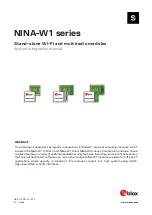
4
Introduction
The D-Link AirPlus Xtreme G™ DWL-2000AP High-Speed Wireless Access Point is a
draft 802.11g high-performance, wireless access point that supports high-speed wireless
networking at home, at work or in public places.
The DWL-2000AP is capable of operating in one of 4 different modes to meet your
wireless networking needs. The DWL-2000AP can operate as an Access Point; in
Access Point-to-Access Point Bridging mode; Access Point-to-Multipoint Bridging mode;
or Wireless Client mode.
The DWL-2000AP is an ideal solution for quickly creating and extending a wireless local
area network (WLAN) in offices or other workplaces, trade shows and special events.
* Available Spring 2003 as a free download
Unlike most access points, the DWL-2000AP provides data transfers at up to 54 Mbps*
(compared to the standard 11 Mbps) when used with other D-Link AirPlus Xtreme G™
products. The 802.11g standard is backwards compatible with 802.11b products. This
means that you do not need to change your entire network to maintain connectivity. You
may sacrifice some of 802.11g’s speed when you mix 802.11b and 802.11g devices, but
you will not lose the ability to communicate when you incorporate the 802.11g standard
into your 802.11b network. You may choose to slowly change your network by gradually
replacing the 802.11b devices with 802.11g devices .
Authentication
is a first line of defense against intrusion. In the Authentication
process the server verifies the identity of the client attempting to connect
to the network.Unfamiliar clients would be denied access.
In addition to offering faster data transfer speeds when used with other 802.11g
products, the DWL-2000AP has the newest, strongest, most advanced security
features available today. When used with other 802.11g WPA (WiFi Protected Access)
and 802.1x compatible products in a network with a RADIUS SERVER, the security
features include:
802.1x*:
A new security feature,
Wi-Fi Protected Access
authorizes and identifies
users based on a secret key that changes automatically at a regular
interval.
WPA
uses
TKIP
(
Temporal Key Integrity Protocol
) to change the
temporal key every 10,000 packets (a packet is a kind of message
transmitted over a network.) This insures much greater security than the
standard WEP security. (By contrast, the older WEP encryption required
the keys to be changed manually.)
WPA:*
*Maximum wireless signal rate based on IEEE Standard 802.11g specifications. Actual data throughput will
vary. Network conditions and environmental factors, including volume of network traffic, building materials
and construction and network overhead lower actual data throughput rate.





































